ABSTRACT
Nitrogen is the mineral element that plants most require. Its deficiency quickly inhibits plant growth. Excessive nitrogen fertilization raises the cost of biomass production. Therefore, there is a need to find the appropriate dose of nitrogen fertilizer that provides greater efficiency in dry matter production. The objective of this study was to evaluate the effects of nitrogen and phosphate fertilizers on the chemical composition of the biomass of elephant-grass for energy use. A randomized-blocks experimental design in a split-plot arrangement was adopted. Three elephant-grass genotypes were evaluated (Guaçu/IZ.2, Cameroon-Piracicaba, and Capim Cana D’África) with five levels of nitrogen fertilization (0, 250, 500, 1,000 and 2,000 kg ha–1), as urea, and four levels of phosphate fertilization (50, 100, 200 and 400 kg ha–1), as single superphosphate. Results showed that the chemical composition, determined by the neutral detergent fiber (NDF), acid detergent fiber (ADF), cellulose (CEL), and lignin (LIG), contents displayed values that qualified the researched genotypes for energy use. Nitrogen applications had a quadratic effect on NDF and LIG contents in genotype Guaçu/IZ.2. A maximum dose of nitrogen fertilizer that will provide greater efficiency in the use of nitrogen for energy use varies among elephant-grass genotypes.
Key words: acid detergent fiber, cellulose, lignin, neutral detergent fiber.
Finite energy sources have put the world system on alert. Fossil fuels (oil, coal, and natural gas) are part of this scenario, and these are highly pollutant and affect the planet’s balance, causing the greenhouse effect. Thus, the search for alternative sources to fossil energies has become a challenge to the world scientific and governmental communities. Elephant-grass is a species of the family Poaceae with great photosynthetic (C4 metabolism) and dry-matter accumulation abilities that can be compared to sugarcane. Research has shown its tremendous advantages compared with other sources energy. The species has great productivity in smaller areas, a shorter productive cycle with better cash flow, the possibility of total mechanization, renewable energy, and higher carbon assimilation (Quesada, 2005; Mazzarella, 2007). In the search for sustainable biomass production for energy generation, the Poaceae species, especially sugarcane (Saccharum officinarum) and elephant-grass (Pennisetum purpureum Schum) stand out for their qualitative features. Fiber represents over 30% of the composition of these plants, which qualifies them for energy production (Urquiaga et al., 1992; Boddey, 1995; Samson et al., 2005; Kauter et al., 2006). When in its fresh state, elephant-grass can be used in direct combustion in ovens, substituting wood and coal, often going through a step of densification and structuring into pellets, cubes, or briquettes. At the energy balance, a ratio of 21.3 units of renewable energy per unit of fossil energy was found in the agricultural production process (Samson et al., 2005). According to Taiz and Zeiger (2009), nitrogen is the mineral element that plants most require. Its deficiency quickly inhibits plant growth. Phosphorus, on the other hand, is an integral component of important plant cell compounds; it is used in the energy metabolism of plants.
Phosphorus is of the macronutrients less required by the plant, but the Brazilian soils are poor in this element. In addition, phosphate fertilization stimulates the nitrogen absorption by the plant (Moreira et al., 2006). The increasing application of nitrogen fertilization significantly increases dry matter production (Flores et al., 2012). And dry matter production is positively correlated with fiber production in elephant-grass (Rossi et al., 2014). Van Soest (1994) stated that the cell wall is composed of low-solubility structural carbohydrates, which correspond to the crude fiber fraction of the forage. The cell wall can be separated into neutral detergent fiber (NDF), which determines its concentration in the plant and expresses the cellulose and hemicellulose; and acid detergent fiber (ADF), which determines the cell wall quality and expresses the lignin, silica, and cutin. NDF and ADF are directly proportional to the calorific value of the material. Lignin is a component of the plant cell wall and an inhibitor of the digestibility of forage plants whose activity increases as the plant matures (Fukushima et al., 2000). Cellulose is the polysaccharide formed by β-glucose units, with high molecular weight (300,000 to 500,000 g mol–1). Having a linear structure, it is the main component of the cell wall (Penedo, 1980). Excessive nitrogen fertilization raises the cost of biomass production. This is because ammonia synthesis requires high investment in fossil energy (Robertson and Grace, 2004). Therefore, there is a need to find the appropriate dose of nitrogen fertilizer that provides greater efficiency in dry matter production. Thus, the objective of this study was to evaluate the effect of nitrogen and phosphate fertilizers on the chemical composition of the biomass of elephant-grass for energy use.
The trial was conducted in the facilities of the
Instituto Federal do Espírito Santo, Alegre Campus, in Espírito Santo State, Brazil (“20º45’57,9” S latitude, “41º27’23,93” W longitude, and 126 m altitude). According to Köppen’s international classification, the climate of the planting region is a Cwa type, that is, a tropical hot and wet type, with cold and dry winters, an average annual temperature of 23.1°C, and total average annual precipitation of 1,341 mm (Lima et al., 2008). The experiment was developed on a soil classified as a Eutrophic Udox (Embrapa, 2006). Soil samples were collected from the 0 to 20 cm layer for an analysis of particle size, whose results were: sand, 76.25%; silt, 2.51%; and clay, 21.23%. The results of the chemical analyses of the soil sampled from the 0 to 20 cm were: pH in water, 5.96; hydrogen + aluminum, calcium, and magnesium, CEC (pH 7.0), 1.93, 1.5, 0.53, and 4.16 cmol dm
–3, respectively; phosphorus, 19 mg dm
–3; and potassium, 67 mg dm
–3. A randomized-blocks experimental design, in a split-plot arrangement, was adopted. Three elephant-grass genotypes (Guaçu/IZ.2, Cameroon-Piracicaba, and Capim Cana D’África) were evaluated, with five levels of nitrogen fertilization and four levels of phosphate fertilization applied. Three replicates were utilized per treatment. The experimental area was formed by thirty-six 12-m rows, and 3.0 m of the extremities of each planting row served as border.
Rows were spaced by 1.5 m, and each block was formed by 60 experimental units with 2.40 m of linear extension. Stems were placed aligned in a row, into furrows, arranged with the base of a plant touching the apex of another plant. Stems, with 50 and 60 cm in length, were covered with 3 cm of soil. A cutting height of 10 cm. Five levels of nitrogen fertilization (0, 250, 500, 1,000, and 2,000 kg ha–1 of urea) were applied in installments during the cycle of the crop (March 05, 2011; October 3, 2011; January 31, 2012; March 17, 2012; and April 21, 2012). Four doses of phosphate fertilizer (50, 100, 200, and 400 kg ha–1 of P205) were applied in the sub-plot, using single superphosphate. The experiment was established on April 22, 2010. Two plot-leveling cuts were made due to climatic factors and flaws encountered at planting. The first plot-leveling cut occurred on October 19, 2010 (180 days after planting), and the second was made on March 02, 2011. The first evaluation harvest was performed on August 29, 2010 (180 days after the last plot-leveling cut), and the second on June 25, 2011 (300 days after the first harvest).
The chemical composition of the biomass was evaluated in the third harvest, made on December 22, 2011 (180 days after the second harvest). The material was weighed, chopped, and placed separately in paper bags, which were immediately dried in a forced-air oven at 65°C for 72 h. Subsequently, samples were weighed and ground in a Wiley mill with 1 mm sieves and conditioned in an airtight container to be analyzed later. The biomass chemical composition characteristics percentage of neutral detergent fiber (NDF), percentage of acid detergent fiber (ADF), percentage of cellulose (CEL), and percentage of lignin (LIG) were evaluated in the Laboratory of Food Analysis of Embrapa Dairy Cattle, in Coronel Pacheco - MG, Brazil, by near infrared reflectance spectroscopy (NIRS), using a Perstorp analytical spectrometer (Silver Spring, MD, model 5000) coupled to a microcomputer equipped with ISI software version 4.1 (Infrasoft International, University, Park, PA). The material was read at the wavelengths of 1,100 to 2,500 nm. Statistical analysis was performed using GENES software (Cruz, 2013). An analysis of variance was initially run based on the average of the sub-subplots, utilizing the following statistical model (split-split-plot):
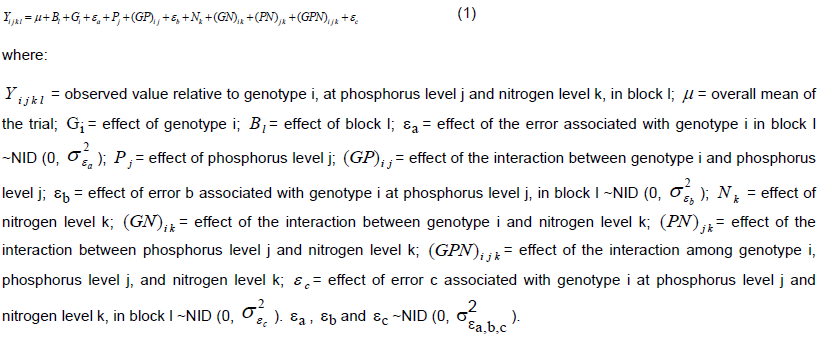
Tukey’s test of means was used for the evaluated characteristics, at a significance level of 5%. For the case of a significant effect involving the source of variation nitrogen levels, a combined polynomial regression analysis was used for the 1st- and 2nd-degree linear models, with the respective analyses of variance of regression, testing the significances of the sources of variation due to regression and due to regression deviations.
The observed coefficients of variation (CV) for NDF, ADF, LIG, and CEL were 1.97, 3.37, 6.61, and 3.89, respectively (Table 1). They were considered low, which indicates good experimental quality for the evaluated characteristics (Cargnelutti and Storck, 2007). A non-significant effect (p > 0.05) was detected for all characteristics evaluated in all sources of variation related to the main effects. The statistical analyses showed that there was no significant interaction involving the different factors for the evaluated chemical composition characteristics. Because of the lack of significance for the sources of variation containing the phosphorus factor isolated (main effect) or interacting with the other factors genotype and nitrogen (genotype × phosphorus, nitrogen × phosphorus, and nitrogen × phosphorus × genotype), the levels of this factor were considered restrictions to the procedures of the other analyses (Table 1). The mean values for the characteristics of the biomass chemical composition (NDF, ADF, LIG, and CEL) resulting from the statistical analyses, for every genotype evaluated as a function of the nitrogen-fertilization levels, are described in Table 2.
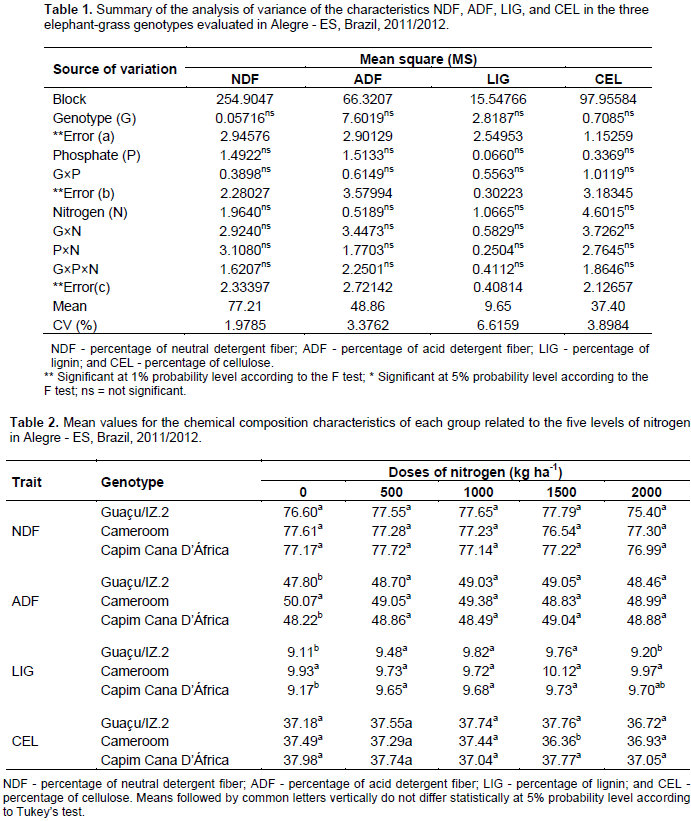
Neutral detergent fiber (NDF) values ranging from 75.40 to 77.79% were found, with nitrogen not affecting the evaluated contents. These values were similar to those obtained by Magalhães et al. (2009), in studies on the effect of nitrogen levels on three elephant-grass genotypes. These authors observed average NDF contents around 70%, with no significant effects of nitrogen fertilization on this characteristic. These values were considered acceptable for the use of elephant-grass as an alternative energy source. Santos (2011) in an experiment with cultivation of elephant-grass found NDF contents between 73.72% (with mineral gypsum) and 76.56% (without gypsum) for Cameroon; 76.71% (with mineral gypsum) and 78.42% (without gypsum) for Gramafante; and 77.26% (with mineral gypsum) and 77.88% (without gypsum) for Roxo. Flores et al. (2013) evaluated the effects of nitrogen fertilization and harvesting age on the quality of elephant-grass biomass and observed mean NDF values of 69 and 58% in the stem and in the leaf, respectively, and that nitrogen fertilization did not influence these concentrations. The mean values for the characteristic percentage of ADF between the analyzed genotypes varied from 47.80 to 50.07% (Table 2).
A significant difference was observed between the means for the lack of nitrogen fertilization, in which the mean of genotype Cameroon stood out among the means of the other genotypes. These values agree with those found by Filho et al. (2000), who, after 100 days of cultivating elephant-grass cultivar Roxo, obtained 48% ADF. Santos et al. (2003) found, in tropical grasses, ADF values of 36 and 38%, in varieties Mott and Pioneiro, respectively. Martins-Costa et al. (2008) were evaluating the nutritive value of elephant-grass at different harvest ages, found percentage values ranging from 41.37 and 49.40%. Rossi (2010) in an experiment with the elephant-grass genotypes Guaçu/IZ.2, Cameroon, and Capim Cana D’África, found values varying between 43.14 and 46.47%. Parente et al. (2012) found ADF contents of 40.53 and 46.40% in elephant-grass subjected to four nitrogen fertilization levels (0, 100, 200, and 300 kg ha–1). Lignin contents (LIG) were found to range from 9.11 to 10.12% (Table 2). A significant difference was observed between the means for the lack of nitrogen fertilization, in which the mean of genotype Cameroon stood out among the genotypes. Genotype Cameroon displayed a significant difference compared with the mean of Guaçu/IZ.2 at the fertilization level of 2,000 kg ha–1. Zanetti et al. (2009) evaluated five elephant-grass genotypes and found LIG values of 9.7 and 13.3% for genotype Cameroon in soils classified as Red-Yellow Ultisol and Haplic Ultisol, respectively.
In an experiment with five elephant-grass genotypes, with plants at 180 days of age, Morais et al. (2009) obtained 9 to 9.7% for this characteristic. Cellulose values were found to range from 36.72 to 37.98% (Table 2). A significant difference was observed between the means for the level of nitrogen fertilization (1500 kg ha–1), with the mean of genotype Cameroon standing out among the others for its lowest value. Zanetti et al. (2009), evaluating elephant-grass genotypes in Red-Yellow Ultisol and Haplic Ultisol soils, found CEL values of 28.7 and 26.8% for genotype Cameroon, respectively. Quesada et al. (2004) found values above 40%. Morais et al. (2009) found CEL values of 33.8 to 35.8%. Results revealed R2 = 91.97%, that is, that 91.97% of the variation in the response NDF are explained by the regression equation y = 76.57 + 0.00261x – 0.00000132x2, with the maximum value estimated at 988.63 kg ha–1 of nitrogen fertilization (Figure 1). For genotypes Cameroon and Capim Cana D'África, no significant effect (p > 0.05) of nitrogen fertilizer influenced the NDF response. The estimate of the mean square for the 2-nd degree linear model for NDF according to the levels of N (fertilizer) for genotype Guaçu/IZ.2 (G1) was significant at 1% probability level, but not at 5%, by the F test. For genotype Guaçu/IZ.2 (G1), the estimates of the mean square due to regression for the 2-nd degree linear model for LIG according to the N (fertilizer) levels were significant at p < 0.01, but not at p > 0.05 by the F test.
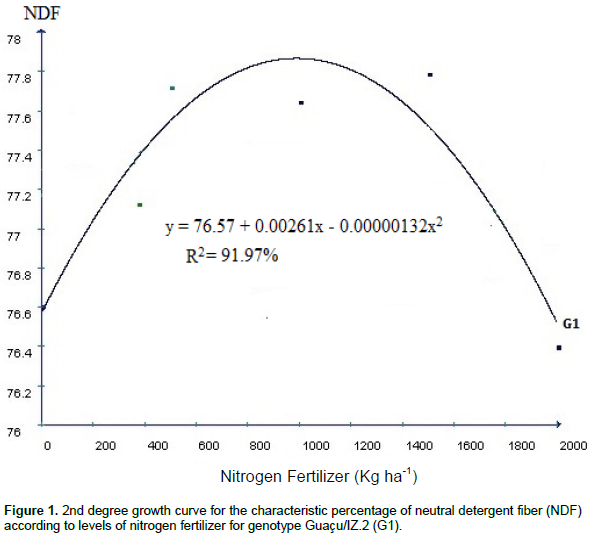
Results demonstrated an R2 = 94.59%, that is, 94.59 of the variation in the response are explained by the regression equation y = 9.06 + 0.0013911x – 0.00000065x2, with maximum value estimated at 1,070.07 kg ha–1 of nitrogen fertilization (Figure 2). Beyond this value, LIG will have a significant linear effect for genotype Capim Cana D’África (G3), the estimates of the mean square due to regression for the 1st-degree linear model for the characteristic LIG as a function of N (fertilizer) levels were significant at p < 0.01. However, at 5% probability, these estimates were not significant. Results showed R2 = 59.18%, that is, 59.18% of the variation in the response are explained by the regression equation y = 9.36 + 0.000227x (Figure 4). Downward trend as the nitrogen fertilization is increased, in this genotype. However, the increase of the nitrogen fertilization does not result in a significant increase in the LIG content from 1500 kg ha-1. The estimates of the mean square for the 1-st degree linear model for CEL according to the N (fertilizer) levels for genotype Cameroon (G2) were significant at p < 0.01 and not significant at p > 0.05, by the F test. These results indicate a reduction of cellulose with an increase in nitrogen fertilization (Figure 3). A similar result was found by Magalhães et al. (2015), who observed a decrease in the fiber content of palisade grass with the increase in the nitrogen fertilization level. In this case, the energy potential was reduced as nitrogen fertilization was increased.
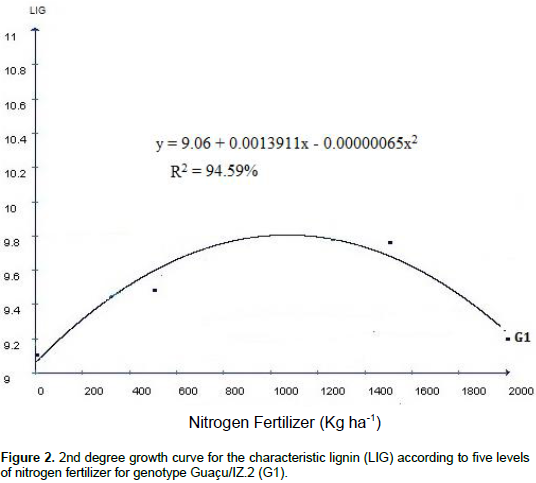
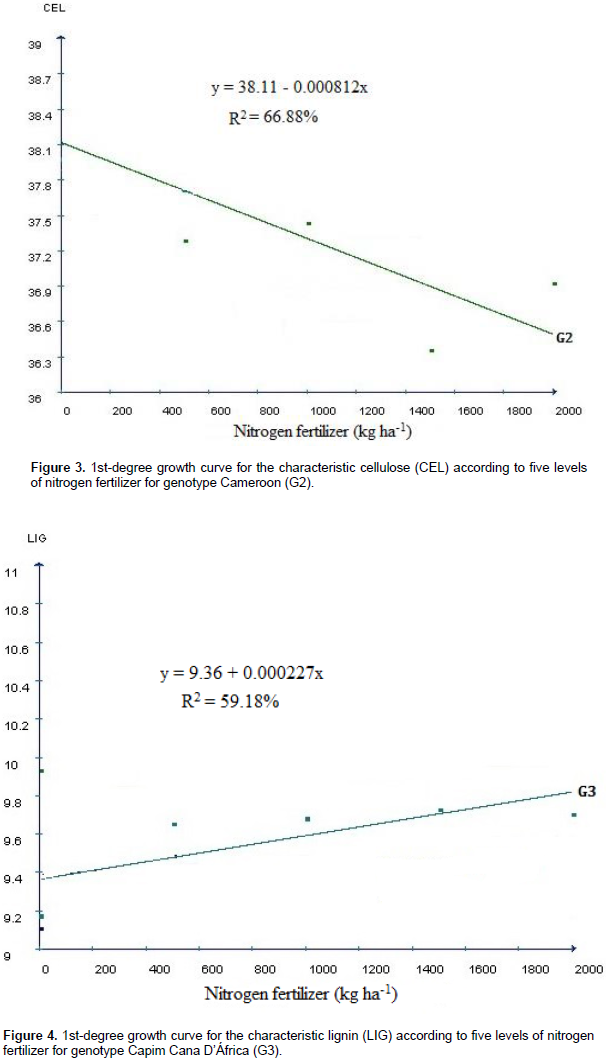
The NDF, ADF, and LIG characteristics showed desirable values for energy use. A maximum dose of nitrogen fertilizer that will provide greater efficiency in the use of nitrogen for energy use varies among elephant-grass genotypes. According to the results presented, these doses would be 1000 kg ha-1 for the Guaçu / IZ.2 genotype and 1500 kg ha-1 dose of nitrogen for the Cameroon and Capim Cana D'Africa genotypes.
The authors have not declared any conflict of interests.
The authors sincere thanks go to the Research Support Foundation of Rio de Janeiro State (FAPERJ), for the financial support for the development of this study.
REFERENCES
|
Boddey RM (1995). Biological nitrogen fixation in sugar cane: A key to energetically viable biofuel production. Crc. Ver. Plant Sci. 14:263-279.
Crossref
|
|
|
|
Cargnelutti Filho A, Storck L (2007). Estatísticas de avaliação da precisão experimental em ensaios de cultivares de milho. Pesqui. Agropecu. Bras. 42:17-24.
Crossref
|
|
|
|
|
Cruz CD (2013). GENES - A software package for analysis in experimental statistics and quantitative genetics. Acta Sci. Agron. 35:271-276.
Crossref
|
|
|
|
|
EMBRAPA. Empresa Brasileira de Pesquisa e Agropecuária (2006). Sistema brasileiro de classificação de solos. 2.ed. Rio de Janeiro: Embrapa Solos.
|
|
|
|
|
Filho QJL, Silva DS, Nascimento IS (2000). Produção de matéria seca e qualidade do capim-elefante (Pennisetum purpureum Schum.) cultivar roxo em diferentes idades de corte. Rev. Bras. Zootec. 29:69-74.
Crossref
|
|
|
|
|
Flores RA, Urquiaga S, Alves BJR, Collier LS, Morais RF, Prado RM (2012). Adubação nitrogenada e idade de corte na produção de matéria seca do capim-elefante no Cerrado. Rev. Bras. Eng. Agríc. Ambient. 16(12):1282-1288.
Crossref
|
|
|
|
|
Flores RA, Urquiaga S, Alves BJR, Collier LS, Zanetti JB, Prado RM (2013). Nitrogênio e idade de corte na qualidade da biomassa de capim-elefante para fins agroenergéticos cultivado em Latossolo. Semina 34:127-136.
|
|
|
|
|
Fukushima RS, Garippo G, Habitante AMQB, Lacerda RS (2000). Extração da lignina e emprego da mesma em curvas de calibração para mensuração da lignina em produtos vegetais. Rev. Bras. Zootec. 29:1302-1311.
Crossref
|
|
|
|
|
Kauter D, Lewandowski I, Claupeina W (2006). Quantity and quality of harvestable biomass from Populus short rotation coppice for solid fuel use. A review of the physiological basis and management influences. Biomass Bioenergy 24:411-427.
Crossref
|
|
|
|
|
Lima JSS, Silva SA, Oliveira RB, Cecílio RA, Xavier AC (2008). Variabilidade temporal da precipitação mensal em Alegre-ES. Rev. Ciênc. Agron. 39:327-332.
|
|
|
|
|
Magalhães JA, Carneiro MSS, Andrade AC, Pereira ES, Rodrigues BHN, Costa NL, Fogaça FHS, Castro KNC, Townsend CR (2015). Composição bromatológica do capim-Marandu sob efeito de irrigação e adubação nitrogenada. Semina 36:933-942.
Crossref
|
|
|
|
|
Magalhães JA, Rodrigues BHN, Carneiro MSS, Andrade AC, Costa NL, Pinto MSC, Mochel Filho WJE (2009). Influência da adubação nitrogenada e da idade de corte sobre os teores de proteína bruta e fibra em detergente neutro de três cultivares de capim elefante. Rev. Eletrôn. Veterinária. Disponível em:
View.
|
|
|
|
|
Martins-Costa RHA, Cabral LS, Bhering M, Abreu JG, Zervoudakis JT, Rodrigues RC, Oliveira IS (2008). Valor nutritivo do capim-elefante obtido em diferentes idades de corte. Ver. Bras. Saúde Prod. 3:397-406.
|
|
|
|
|
Mazzarella V (2007). Jornada Madeira Energética- Capim Elefante como fonte de energia no Brasil: Realidade Atual e Expectativas. IPT-BNDS -Rio de Janeiro.
|
|
|
|
|
Morais RF, Zanetti JB, Pacheco BM, Jantália CP, Boddey RC, Alves BJR, Urquiaga S (2009). Produção e qualidade da biomassa de diferentes genótipos de capim-elefante cultivados para uso energético. Rev. Bras. Agroecol. 4:1103-1107.
|
|
|
|
|
Moreira LM, Fonseca DM, Martuscello JÁ, Nobrega EB (2006). Adubação fosfatada e níveis críticos de fósforo no solo para manutenção da produtividade do capim-elefante (Pennisetum purpureum cv. Napier). R. Bras. Zootec. 3(35):943-952.
Crossref
|
|
|
|
|
Parente HN, Bandeira JR, Rodrigues RC, Oliveira M, Parente M, Tosta XM, Silva Junior OR (2012). Crescimento e valor nutritivo do capim-elefante submetido à adubação orgânica e mineral. Rev. Bras. Agropec. Sustent. 2:132-141.
|
|
|
|
|
Penedo WR (1980). Uso da madeira para fins energéticos. Belo Horizonte. Fundação CETEC. (CETEC. Publicações Técnicas/SPT-001). Coletanea dos trabalhos apresentados durante o Curso "Uso da madeira para fins energeticos", Belo Horizonte, MG, CETEC. 158 p.
View
|
|
|
|
|
Quesada DM (2005). Parâmetros quantitativos e qualitativos da biomassa de genótipos de capim elefante (Pennisetum purpureum Schum.) com potencial para uso energético, na forma de carvão vegetal. 2005. 65f. Tese (Doutorado em Agronomia Ciência do Solo) Universidade Federal Rural do Rio de Janeiro, Seropédica. 2005
|
|
|
|
|
Quesada DM, Boddey RM, Reis VM, Urquiaga S (2004). Parametros qualitativos de genótipos de capim-elefante (Pennisetum purpureum Schum.) estudados para a produção de energia através da biomassa. Circular Técnica 8.
View
|
|
|
|
|
Robertson GP, Grace PR (2004). Greenhouse gas fluxes in tropical and temperate agriculture: the need for a full-cost accounting of global warming potentials. Environ. Dev. Sustain. 6:51-63.
Crossref
|
|
|
|
|
Rossi DA (2010). Avaliação Morfoagronômica e da Qualidade da Biomassa de Acessos de Capim-Elefante (Pennisetum Purpureum Schum.) para fins Energéticos no Norte Fluminense. Dissertação de mestrado, Universidade Estadual do Norte Fluminense Darcy Ribeiro, Campos dos Goytacazes-RJ, Brasil.
View
|
|
|
|
|
Rossi DA, Menezes BRS, Daher RF, Gravina GA, Lima RSN, Ledo FJS, Gottardo RD, Campostrini E, Souza CLM (2014). Canonical correlations in elephant grass for energy purposes. Afr. J. Biotechnol. 13:3666-3671.
Crossref
|
|
|
|
|
Samson R, Mani S, Boddey R, Sokhansanj S, Quesada D, Urquiaga S, Reis V, Ho Lem C (2005). The potential of C4 perennial grasses for developing a global BIOHEAT industry. Crc. Rev. Plant Sci. 24:1-35.
|
|
|
|
|
Santos MVF, Dubeux Jr JCB, Silva MC, Santos SF, Ferreira RLC, Mello ACL, Farias I, Freitas EV (2003). Produtividade e composição química de gramíneas tropicais na zona da mata de Pernambuco. Rev. Bras. Zootec. 32:821-827.
Crossref
|
|
|
|
|
Santos RL (2011). Produção de biomassa de capim elefante como fonte alternativa de energia em Pernambuco. Dissertação de mestrado, Universidade Federal Rural de Pernambuco, Recife.
|
|
|
|
|
Taiz L, Zeiger E (2009). Fisiologia vegetal. 3.ed. Porto Alegre: Artmed.
|
|
|
|
|
Urquiaga S, Cruz KHS, Boddey RM (1992). Contribution of nitrogen fixation to sugar cane: nitrogen-15 and nitrogen balance estimates. Soil Sci. Soc. Am. J. 56:105-114.
Crossref
|
|
|
|
|
Van Soest PJ (1994). Nutriticional ecology of the ruminant. 2.ed. Oregon: O & B Books. 373 p.
|
|
|
|
|
Zanetti JB, Morais RF, Leite JM, Soares LHB, Jantalia CP, Alves BJR, Boddey R, Urquiaga SS (2009). Produção e qualidade da biomassa de genótipos de capim-elefante para uso como fonte de energia. In: 4 Congresso Internacional de Bioenergia, 2009, Curitiba. 4 Congresso Internacional de Bioenergia.
|
|